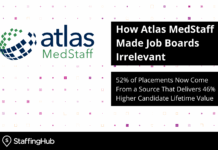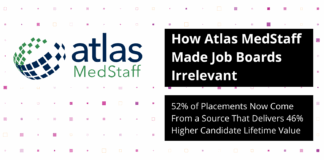
Key takeaways:
- Strategic advantage: AI applications beyond chatbots — including talent intelligence platforms and predictive analytics — are delivering measurable ROI through reduced hiring costs, improved quality of hire, and significantly faster time-to-fill metrics.
- Operational transformation: Implementing advanced AI tools can reduce time spent on candidate sourcing while simultaneously improving match quality, allowing recruitment professionals to focus on strategic relationship-building and candidate experience.
- Competitive necessity: The question isn’t whether to adopt these technologies, but how quickly and strategically you can implement them before competitors gain an insurmountable advantage.
The AI revolution in staffing isn’t coming — it’s already here. And it’s not just about automating tedious tasks. Today’s cutting-edge AI applications are predicting candidate success with stunning accuracy, uncovering hidden talent pools, and delivering strategic insights that were, until just recently, unimaginable.
According to McKinsey’s 2025 State of AI report, 78% of organizations now use AI in at least one business function, up from 72% in early 2024 and 55% a year earlier. And the Society for Human Resource Management (SHRM) notes that adoption has spiked most significantly in talent acquisition, with GenAI becoming an essential competitive differentiator in the staffing industry.
Let’s explore five advanced AI applications beyond basic chatbots that are delivering measurable business impact for staffing leaders today.
1. AI-powered talent intelligence platforms
While basic applicant tracking systems have become commoditized, next-generation talent intelligence platforms are leveraging AI to transform how staffing firms understand and engage with their talent pools.
What it is: Advanced AI systems that continuously analyze massive datasets of candidate information, creating dynamic talent profiles that go far beyond standard resume parsing. These platforms identify patterns in candidate behavior, preferences, and career trajectories that human recruiters simply couldn’t detect at scale.
Business impact: Leading enterprise platforms now use proprietary datasets of over 1.5 billion talent profiles and skills to generate AI-powered recommendations on how and when organizations should build, buy, or borrow talent. This fundamentally changes the strategic approach to talent acquisition.
For staffing executives, this means the ability to:
- Predict candidate availability before they actively enter the job market
- Understand nuanced skill relationships and transferability across industries
- Identify emerging talent pools before competitors
ROI metrics: Organizations implementing AI talent intelligence platforms report significant improvements in strategic metrics. According to a Harvard Business Review study, 91% of senior business and HR leaders believe optimizing hiring processes with AI is necessary for long-term business success, with improved candidate quality being a primary driver of this sentiment.
2. Predictive analytics for hiring outcomes
While traditional recruitment has relied heavily on intuition and experience, AI-powered predictive analytics is bringing data-driven precision to hiring decisions.
What it is: Advanced algorithms that analyze historical placement data, market trends, and candidate characteristics to forecast hiring outcomes with remarkable accuracy. These systems go beyond simple keyword matching to predict candidate success, time-to-fill metrics, and even retention likelihood.
Business impact: Predictive AI can significantly improve both the efficiency and quality of hiring decisions, allowing staffing firms to proactively address retention risks and optimize placement strategies. For staffing leaders, predictive analytics provides:
- Data-driven guidance on which candidates are most likely to succeed in specific roles
- Accurate forecasting of time-to-fill metrics for different positions and industries
- Early identification of retention risks in placed candidates
ROI metrics: The financial impact is substantial. Organizations that excel at implementing AI solutions are seeing measurable business impacts across their operations, including in talent acquisition where predictive analytics improves hiring precision and efficiency.
Industry analysis highlights how predictive analytics is transforming recruiting strategies. By analyzing data points like tenure, career progression, and social media activity, recruiters can identify suitable passive candidates who might be ready for a new opportunity.
3. Automated sourcing and matching technology
While manual sourcing remains time-consuming and inconsistent, AI-powered sourcing and matching technology is dramatically enhancing recruiter productivity.
What it is: Advanced AI systems that autonomously search internal databases and external platforms to identify candidates matching specific job requirements. These systems go beyond keyword matching to understand semantic relationships, infer skills from experience, and match based on multiple dimensions of compatibility.
Business impact: According to SHRM’s reporting on AI adoption in recruitment, organizations are increasingly using AI tools to streamline processes, with a significant number of recruiters implementing these technologies to improve sourcing efficiency. As industry expert Tom Gimbel notes in SHRM’s coverage, “companies are embracing this technology to alleviate administrative burdens, freeing up valuable time for employees to engage in more innovative and fulfilling tasks.”
For staffing executives, automated sourcing and matching provides:
- Significantly faster candidate identification for urgent roles
- More consistent quality in candidate shortlists
- Ability to scale operations without proportional headcount increases
ROI metrics: Organizations implementing AI sourcing and matching report dramatic efficiency gains. LinkedIn’s Future of Recruiting 2024 report indicates that finding high-quality candidates has become the top objective for recruiting professionals, with AI-powered sourcing technologies playing a crucial role in achieving this goal.
4. Augmented interviewing and assessment
While traditional interviewing remains subjective and inconsistent, AI-augmented interviewing and assessment is bringing standardization and deeper insights to the candidate evaluation process.
What it is: Advanced AI systems that assist in structured interviewing, skills assessment, and candidate evaluation. These technologies help create consistent interview experiences, reduce bias, and identify indicators of success that human interviewers might miss.
Business impact: According to implementation data from McKinsey’s AI in the Workplace 2025 report, AI-augmented interviewing has been crucial for large enterprises hiring thousands of associates annually. These systems can help recruiters:
- Conduct more structured, consistent interviews across large hiring teams
- Identify subtle indicators of candidate fit and potential
- Reduce unconscious bias in the evaluation process
ROI metrics: The adoption of these technologies is growing rapidly as organizations discover the clear benefits of applying AI to the interview process. By standardizing assessment criteria, removing unconscious biases, and identifying candidate qualities that might be missed in traditional interviews, these systems are helping companies make more consistent, data-informed hiring decisions.
5. AI-driven workforce planning systems
While traditional workforce planning relies on historical patterns and intuition, AI-driven systems are enabling more sophisticated, forward-looking approaches.
What it is: Advanced AI systems that analyze labor market trends, internal performance data, and economic indicators to forecast future workforce needs with unprecedented accuracy. These platforms help staffing leaders anticipate demand, identify emerging skill requirements, and optimize talent acquisition strategies accordingly.
Business impact: For staffing executives, AI-driven workforce planning provides:
- More accurate forecasting of client hiring needs
- Early identification of emerging skill demands before competitors
- Data-driven guidance on which industries and roles to focus recruiting efforts
ROI metrics: The strategic value is substantial. Organizations implementing AI-driven workforce planning gain a critical competitive advantage in anticipating market shifts and aligning talent strategies accordingly.
Successful AI implementation
As we’ve seen, the question isn’t whether to adopt advanced AI applications, but how to implement them strategically for maximum competitive advantage. The global AI recruitment market is experiencing explosive growth, with organizations rapidly scaling their AI investments across the talent lifecycle.
Effective implementation requires addressing three key challenges:
- Integration: If existing systems don’t integrate well with AI tools, it can create a significant barrier to adoption. Successful implementations require careful planning for system interoperability.
- Change management: Change champions are essential for getting all employees on board and excited about new AI technologies. Without proper change management, even powerful AI tools may sit unused.
- Data quality: The effectiveness of AI applications depends entirely on the quality of data they’re trained on. Organizations must prioritize data cleaning and governance as part of their AI strategy.
AI is redefining what’s possible in talent acquisition and management. While chatbots were just the beginning, these five advanced applications represent the true transformative potential of AI in staffing.
As AI continues to revolutionize recruitment, making hiring processes more efficient, data-driven, and unbiased, staffing firms must act now to harness these capabilities or risk being left behind.





